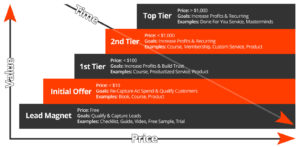One of the foundational problems in any digital marketing project is to understand and define the products you have and try to better structure what you offer. This is important because you may be losing money if you do not fully understand what is your offer and associated offers.
Structuring your Offer
The most important thing you need to do in your business or online project is to define what your offer is/what your products are. This is fundamental not only for you to organize what you are doing but most importantly for your digital marketing strategy.
Digital marketing basically aims to sell something to someone. And this something it is trying to sell are products (physical or in other forms). But this offer needs organization. Depending on the size of your offer there are four main things that need to be done.
The starting point for anyone who is organizing the offer is to ask what categories do I have? Sometimes there is a straight answer to this question. For example a car dealership can sell cars, rent cars, insurance services or even other physical products.
It may however be the case that there are sub-categories inside the broad categories. This is most common in e-commerce shops. For example, people may want shoes but there are different types of shoes to choose from. So inside the broad category shoes there are different options available.
E-commerce business pose different challenges for digital marketers when compared to service-based businesses.
Once we understand what the main categories and sub-categories of our business are, it is time to finally start defining what are the products inside each category/sub-category. For example, imagining we are still selling cars we could be selling Fords, Hondas or Ferraris. And of course, there are different types of Fords, Hondas or Ferraris.
Then you need to structure your value-ladder. Defining your value-ladder is important because it will allow you to increase your lifetime customer value. In other words, you need to define what the upsell structure of your business is.
Imagine you sell a car to someone – of course you are not going to sell another car to your customer (unless he really wants to).
But you could certainly offer your insurance service or a maintenance programme.
If you want to increase your revenue you need to write down what your products are and what you can offer on top of those products – and if you do have this offer you need to create it.
The break down:
- Lead Magnets are usually freebies (coupons, videos, checklists, etc.) that attract and qualify leads
- Initial Offers are lower-end products/services that are ideally “too good to refuse” and get people in the door
- 1st Tier Offers are usually your core product or service and bring in about 80% of your sales
- 2nd Tier Offers are the “next” level up from the 1st tier
- Top Tier Offers are the best you have to offer, the full shebang!

Service-based Businesses
Service-based businesses are different from e-commerce businesses normally. And, broadly speaking, one can distinguish 4 main “categories” of services – digital products, coaching, consulting and services/masterminds. This can also take the form of an ascending ladder as shown in the picture.

But of course, when applied in practice the ascending latter should be dissected. Let’s take the two following examples: financial advisors and a dentist and imagine the financial adviser sells digital products and services and the dentist only sells services.
This is how an offer could look like.
Financial Advisor (digital products, services)
- Digital Products (SaaS service similar to Mint and/or Wealthfront)
- Lead Magnets: Trial
- Initial Offer: Self managed
- Top Tier: Professionally managed
- Services
- Lead Magnet: 7 Questions To Ask Before Hiring A Financial Advisor
- Initial Offer: Free 15 minute Q&A
- Top Tier: Investment management, retirement planning, college planning, estate planning, debt reduction strategy
Dentist (services)
- Services
- Lead Magnet: Free teeth cleaning
- Initial Offer: Teeth whitening
- 1st Tier: Cavities, fillings, and other minor fixes
- Top Tier: Braces
- Recurring: 6 month appointments
E-commerce Shops
The best way to structure the offer of online shops is by the products they sell. What are the main categories and sub-categories, and then decide what the main products inside this scheme are. Once this is done we need to set a particular upsells structure. Let’s take the two example below.
Cordless Power Tools Store
- Lead Magnet: 20% off coupon
- Initial Offer(s): House Maintenance For Dummies book, simple project kits to build with kids (like a birdhouse kit)
- 1st Tier Offer(s): Cordless power tools (drills, circular saws, blowers, etc)
- 2nd Tier Offer(s): High end toolboxes, work benches, etc.
- Top Tier Offer(s): Custom built workshop sheds
Women’s Clothing And Accessories Store
- Lead Magnet: 20% off coupon
- Initial Offer(s): Sunglasses, T-Shirts
- 1st Tier Offer(s): Sun dresses, swim suits
- 2nd Tier Offer(s): Business attire (suits, dresses)
- Top Tier Offer(s): Formal wear, wedding dresses, etc
How to Implement?
Once you have defined what the structure of your offer is the next step is to set up a sales funnel so your customers can start taking advantage of what you have to offer.




